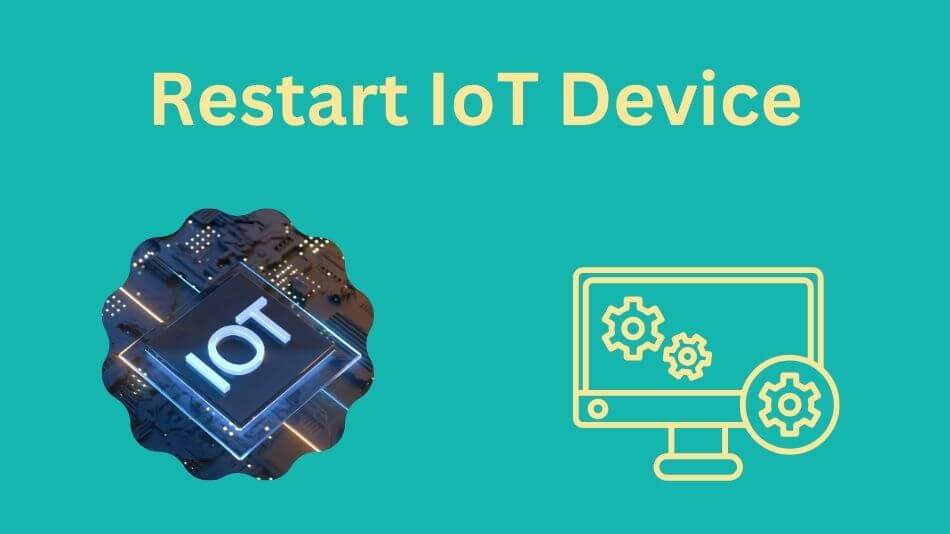Introduction: Restart IoT Device

In the rapidly evolving world of technology, the Internet of Things (IoT) has become an integral part of our lives.
IoT devices offer convenience and automation, from smart thermostats to connected security cameras.
However, like any technology, these devices may encounter issues requiring restart.
In this comprehensive guide, we will delve into the world of IoT and explain how to restart IoT devices to resolve common problems and ensure optimal performance.
Why Restart IoT Devices?
IoT devices are designed to make our lives easier and more efficient. Yet, just like any other technology, they can experience occasional hiccups that disrupt their functionality. Restarting an IoT device can help in various situations:
Resolve Connectivity Issues
- Sometimes, IoT devices lose their connection to the network, leading to communication problems. A simple restart can reestablish the connection.
Software Updates
- Restarting your IoT device may be necessary after a software update to ensure the changes take effect.
Performance Optimization
- Regular restarts help clear memory and refresh the device’s operations, enhancing overall performance.
Troubleshooting
- If your device is acting unexpectedly, restarting it is often the first step in diagnosing and resolving the issue.
How to Restart IoT Devices
Different IoT devices may require slightly different approaches for restarting. Here’s a step-by-step guide on how to restart common IoT devices:
- Restarting Smartphones or Tablets
- Locate the power button.
- Press the power button until the device prompts you to shut down.
- Follow the on-screen instructions to turn the device off.
- Once it’s off, press the power button again to turn it back on.
- Restarting Smart Home Hubs
- Unplug the power cord from the hub.
- Wait for 10-15 seconds.
- Plug the power cord back in.
- Allow the hub to boot up, which may take a minute or two.
- Restarting Smart Appliances
- Unplug the appliance from the power source.
- Wait for 30 seconds.
- Plug the appliance back in and turn it on.
- Restarting Smart Security Cameras
- Access the camera’s settings in the associated app.
- Look for the “Restart” or “Reboot” option and select it.
Advanced Tips for Restarting IoT Devices
While the basic restart procedures for IoT devices are relatively simple, some advanced tips can help you make the most out of the process:
Scheduled Restarts
You can set up scheduled restarts for your IoT devices to maintain optimal performance.
Many smart hubs and routers have this feature. Regular automated restarts can clear any accumulated issues and improve reliability.
Backup Your Settings
Before rebooting an IoT device that controls home security or smart appliances, it is wise to back up its settings and configurations in case something goes awry during its restart.
That way, you can easily restore its previous state if anything goes amiss during its reboot process.
Check for Firmware Updates
Keep an eye on the performance and connectivity of your IoT devices, monitoring any persistent issues or frequent reboots for signs that a deeper issue requires support from either manufacturer or support team.
Monitor Device Health
Keep an eye on the performance and connectivity of your IoT devices. If you notice persistent issues or a need for frequent restarts, it could be a sign of an underlying problem that requires attention from the manufacturer or support team.
Group Device Restarts
If you have multiple IoT devices from the same manufacturer, restarting them in groups rather than individually is often more efficient.
Some apps and control interfaces can restart all devices from one manufacturer simultaneously.
Frequently Asked Questions: Restart IoT Device

Q1: When should I restart my IoT device?
A1: You should restart your IoT device when it experiences connectivity issues, after software updates, for performance optimization, or when troubleshooting unexpected behavior.
Q2: How often should I restart my IoT devices?
A2: The frequency of restarts can vary, but a good rule of thumb is to restart devices like smart hubs and cameras at least once a month for optimal performance.
Q3: Will restarting my IoT device erase my settings?
A3: Restarting should not erase your device’s settings or configurations. However, it’s a good practice to double-check settings after a restart.
Q4: What if my IoT device doesn’t respond to a restart?
A4: If a simple restart doesn’t work, consult the manufacturer’s support documentation or reach out to their customer support for guidance.
Q5: Can I automate the restart of my IoT devices?
A5: Some IoT devices allow you to schedule regular restarts for maintenance purposes. Check the device’s settings or app for such options.
Conclusion: Restart IoT Device

IoT devices have become indispensable in modern life, making daily tasks more efficient and convenient. However, they are not immune to occasional hiccups.
Knowing how to restart IoT devices is a valuable skill to resolve common issues, ensure software updates take effect, and optimize performance.
By following the guidelines in this guide, you can keep your IoT devices running smoothly and enjoy the full benefits of a connected home or workplace.
So, when your IoT device is acting up, remember to restart it – it might be the simple solution you need to get things back on track!
